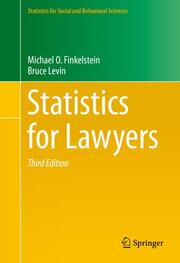Detailansicht
Statistics for Lawyers
Statistics for Social Science and Behavorial Sciences, Statistics for Social and Behavioral Sciences
ISBN/EAN: 9781441959843
Umbreit-Nr.: 1671576
Sprache:
Englisch
Umfang: xxxii, 657 S., 56 s/w Illustr., 657 p. 56 illus.
Format in cm:
Einband:
gebundenes Buch
Erschienen am 16.12.2015
Auflage: 3/2016
- Zusatztext
- This classic text, first published in 1990, is designed to introduce law students, law teachers, practitioners, and judges to the basic ideas of mathematical probability and statistics as they have been applied in the law. The third edition includes over twenty new sections, including the addition of timely topics, like New York City police stops, exonerations in death-sentence cases, projecting airline costs, and new material on various statistical techniques such as the randomized response survey technique, rare-events meta-analysis, competing risks, and negative binomial regression. The book consists of sections of exposition followed by real-world cases and case studies in which statistical data have played a role. The reader is asked to apply the theory to the facts, to calculate results (a hand calculator is sufficient), and to explore legal issues raised by quantitative findings. The authors' calculations and comments are given in the back of the book. As with previous editions, the cases and case studies reflect a broad variety of legal subjects, including antidiscrimination, mass torts, taxation, school finance, identification evidence, preventive detention, handwriting disputes, voting, environmental protection, antitrust, sampling for insurance audits, and the death penalty. A chapter on epidemiology was added in the second edition. In 1991, the first edition was selected by the University of Michigan Law Review as one of the important law books of the year.
- Kurztext
- This classic text, first published in 1990, is designed to introduce law students, law teachers, practitioners, and judges to the basic ideas of mathematical probability and statistics as they have been applied in the law. The third edition includes over twenty new sections, including the addition of timely topics, like New York City police stops, exonerations in death-sentence cases, projecting airline costs, and new material on various statistical techniques such as the randomized response survey technique, rare-events meta-analysis, competing risks, and negative binomial regression. The book consists of sections of exposition followed by real-world cases and case studies in which statistical data have played a role. The reader is asked to apply the theory to the facts, to calculate results (a hand calculator is sufficient), and to explore legal issues raised by quantitative findings. The authors' calculations and comments are given in the back of the book. As with previous editions, the cases and case studies reflect a broad variety of legal subjects, including antidiscrimination, mass torts, taxation, school finance, identification evidence, preventive detention, handwriting disputes, voting, environmental protection, antitrust, sampling for insurance audits, and the death penalty. A chapter on epidemiology was added in the second edition. In 1991, the first edition was selected by the University of Michigan Law Review as one of the important law books of the year.Michael O. Finkelstein was a practicing lawyer in New York City (now retired). He has for many years been a member of the adjunct faculty of Columbia University Law School, teaching statistics for lawyers, and has also taught that subject at Harvard University, Yale University, and the University of Pennsylvania law schools. He is the author of a book of essays, Quantitative Methods in Law, and a monograph, Basic Concepts of Probability and Statistics in the Law, as well as numerous law review articles on the applications of statistics in law. His articles have been cited by the U.S. Supreme Court and other courts. He has been for many years the editor of two law journals, The Review of Securities and Commodities Regulation and The Review of Banking and Financial Services, and is currently their publisher as well. Bruce Levin is Professor and past Chair of the Department of Biostatistics at the Joseph L. Mailman School of Public Health of Columbia University. He is a Fellow of the American Statistical Association and an American Public Health Association Statistics Section Award winner. Dr. Levin has a long-standing interest in statistical methodology for clinical trials, public health, and the law. Using sequential statistical methods, he has developed innovative trial designs, has served as the senior statistical designer for many randomized clinical trials, and has authored numerous articles on the subject of biostatistics. He consults and testifies as an expert in legal cases involving statistical issues.
- Autorenportrait
- Michael O. Finkelstein was a practicing lawyer in New York City (now retired). He has for many years been a member of the adjunct faculty of Columbia University Law School, teaching statistics for lawyers, and has also taught that subject at Harvard University, Yale University, and the University of Pennsylvania law schools. He is the author of a book of essays, Quantitative Methods in Law, and a monograph, Basic Concepts of Probability and Statistics in the Law, as well as numerous law review articles on the applications of statistics in law. His articles have been cited by the U.S. Supreme Court and other courts. He has been for many years the editor of two law journals, The Review of Securities and Commodities Regulation and The Review of Banking and Financial Services, and is currently their publisher as well. Bruce Levin is Professor and past Chair of the Department of Biostatistics at the Joseph L. Mailman School of Public Health of Columbia University. He is a Fellow of the American Statistical Association and an American Public Health Association Statistics Section Award winner. Dr. Levin has a long-standing interest in statistical methodology for clinical trials, public health, and the law. Using sequential statistical methods, he has developed innovative trial designs, has served as the senior statistical designer for many randomized clinical trials, and has authored numerous articles on the subject of biostatistics. He consults and testifies as an expert in legal cases involving statistical issues.
